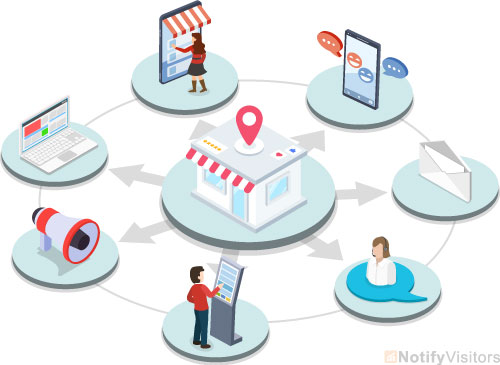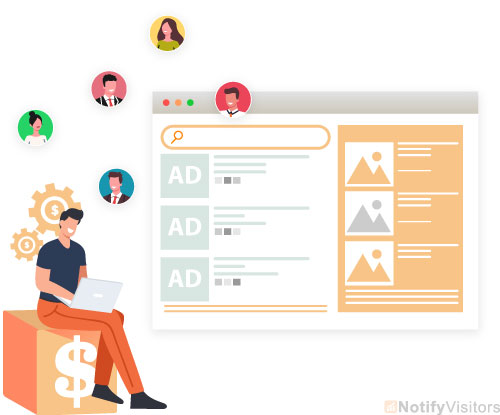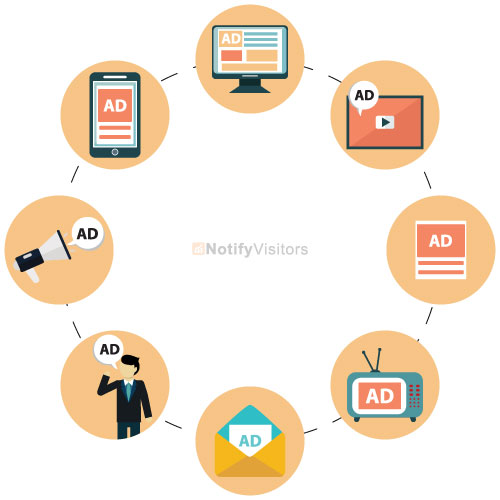Extensive use of the internet has provided today’s consumers with multiple platforms to find info about and interact with people and brands.
So, it is no longer enough for businesses and their marketers to approach their audiences through single channels alone. They need to gain a holistic idea of their audience.
This is where cross-channel marketing comes of help.
This blog tells you what cross-channel marketing is, why it is important today, how to build an effective cross-channel marketing strategy, what are the challenges it faces, and more.
You’ll gain comprehensive knowledge of cross-channel marketing from our blog. So, let’s begin.
Contents
What is cross-channel marketing?

Cross-channel marketing is a marketing technique that provides customers with a holistic, personalized and consistent experience across multiple marketing channels.
It is a digital, strategic, and customer-focused approach that creates a cohesive customer journey for a business’s target audience.
Cross-channel marketing allows businesses and their marketers to seamlessly interact with consumers via different touchpoints to create an effective customer journey. If done rightly, your digital marketing efforts can be profitable.
However, implementing a cross-channel marketing strategy is an intimidating process as you have to take into account multiple channels while designing your campaigns.
Why is cross-channel marketing important?
Consumers today look for highly personalized experiences. As most of them look for information online to plan their shopping, finalize options, and make purchasing decisions.
As brands cater to this need, they should offer an integrated experience across consumer touchpoints during their customer journey.
For example, integrating a free barcode reader into your mobile app strategy can enhance the shopping experience by allowing customers to quickly access product information and exclusive deals.
This is important as the majority of consumers use more than one touchpoint to complete their buying decision. For instance, he may get to know your product/brand through a social media post, and then visit your site to know more about it.
There he might chat with a customer service agent who may move him closer to the deal by making a lucrative offer. And then he might complete the purchase.
This necessitates a cross-channel marketing mechanism. A cross-channel marketing strategy can create brand awareness, bring in leads, and drive sales. At any given point in time, your users are likely to explore different marketing channels.
So, you need to make your messaging more close-knit by integrating these touch-points. No wonder cross-channel marketing is becoming one of the prime digital marketing trends.
Now that you’ve understood the importance of cross-channel marketing, let’s get to know how to build an effective cross-channel marketing strategy.
How to build an effective cross-channel marketing strategy?
When you design your brand’s cross-channel marketing strategy, remember the following three things.
1. Incorporate consistency
Most consumers expect brands to stay consistent across different touchpoints. A study by Interactive Advertising Bureau (IAB) revealed that purchase intent increases by 90% and brand perception by 68% when users see consistent messaging across various touchpoints.
So, make sure that you offer a consistent experience across channels. Maintain consistency in terms of communication tone, content strategies, and brand principles to benefit from cross-channel marketing.
2. Optimize the Marketing Funnel
Another key element to consider while designing your cross-channel marketing strategy is optimizing the marketing funnel with context-specific messaging.
With today’s advancements facilitating real-time marketing, you can create a seamless user experience for prospects/customers as they pass through different channels.
You can also successfully re-target prospects/customers across channels. For instance, when you establish retargeting campaigns to get to your website drop-offs, include email and social media to the mix.
This multi-channel strategy will enable optimizing the campaign further to increase your marketing ROI.
3. Increase engagement

Customers that use different channels are very valuable for your brand. A study says that 62% of participants who engage with brands across 10 or more channels buy once or more each week.
This is because engaging interactions create emotional connections that convert your target audience into loyal customers. Customers interact with brands on different platforms.
So, get your brand in front of them to drive successful engagement. You may post shareable content and use hashtags to encourage users to share your content. This will help build engagement.
4. Evaluate the outcomes

An effective way to measure the impact of cross-channel marketing campaigns is to test with control groups.
A control group refers to a group of users who aren’t served ads from your cross-channel marketing campaigns.
Use different control groups that aren’t targeted by any of these ads to measure the performance of your marketing campaigns.
By looking at the metrics, you’ll be able to determine which campaign is successful, which needs to be optimized more, and which should be completely abandoned.
After you’ve tested and evaluated your campaigns, you can send the same campaign to the control group, if required. This way, you can refrain from sending the wrong campaign to your entire audience at once.
Challenges of cross-channel marketing
Cross-channel marketing can be challenging as it integrates multiple marketing channels and converts a simple customer journey into a refined and complicated one. This creates some common challenges. Those are discussed below-
1. Reaching consumers at the right time
Since cross-channel marketing integrates multiple marketing channels, it can be tough for marketers to choose the right path to effectively reach their consumers at the right time.
With numerous options available, guessing the best platform and time to reach the audience can be troublesome. This is especially because these platforms may be changing both in marketing/advertising capabilities and user intent.
2. Gaining high-quality data for superior insights
Another challenge for many businesses is data quality. Companies are increasingly collecting a lot of data. This makes it vital to understand what data is truly contextual for comprehending customer behaviour and increasing efficiency.
The higher the quality of data, the more precise will the insights derived be. Without high-quality data, it is hard for businesses and their marketers to come up with actionable insights to drive better decisions.
3. Choosing the right advertising platforms

Yet another challenge for cross-channel marketing is choosing the right advertising platform. This is because it is hard to determine the platforms where your consumers are spending most of their time and when.
This necessitates comprehending the audience on a granular level. Further, campaigns have to work synchronously across the channels your consumers engage with. So, you need to evaluate and choose the right channels.
4. Choosing accurate marketing attribution
Many brands are lagging concerning marketing attribution. Marketers still focus on metrics like click-through rates while neglecting other metrics.
For instance, say 2% of viewers click through a link the remaining 98% who viewed it but did not click will go uncounted, even if it might have led to a conversion later.
So, marketers should employ an all-inclusive approach to attribution by merging raw data and person-level insights.
Examples of brands using cross-channel marketing
If executed rightly, cross-channel marketing can help brands understand their consumers better and optimize their future campaigns accordingly. Let’s look at some brands that found success with cross-channel marketing.
1. Mercedez Benz
Mercedez Benz adopted a cross-channel marketing strategy that combined both digital and offline techniques to launch its CLA model. It combined a microsite for the model, TV ads, social media promotion, and video content.
Later, the brand stated that it was their best product launch in 20 years. For, one million online viewers had watched their CLA content.
2. Starbucks
Starbucks provides an integrated experience that combines website updates, personalized recommendations, push notifications, AI, in-app messaging, and phone calls.
They also maintained consistency across the marketing channels. This cross-promotion got more people to download and use their app.
3. Heineken
Heineken’s cross-channel marketing emphasizes consistency as the prime success factor. It marketed its video that was tied to a web series called “Dropped” on multiple channels including its website, Facebook, Twitter, Instagram, and YouTube.
Though it was a kind of visual engagement, the viewers started associating its message with the brand.
4. Under Armour
This fitness brand blends together social media presence, in-store content, influencer marketing, and interactive engagement with its Connected Fitness community and its shopping app.
It also delivers personalized experiences based on user data. Another marketing technique it employs is enabling customers to scan barcodes across the store to learn more about specific products.
This increased traffic and engagement on their website, social media platforms, apps, and in their stores.
Final Thoughts
By employing a cross-channel marketing strategy, your brand will be able to ensure a consistent user journey across all marketing channels. You can use the advanced solutions available today to refine and optimize your marketing campaigns.
You can also use these tools for continually monitoring the performance of campaigns across every channel. This will ensure a cohesive experience that motivates engagement and boosts brand affinity and customer retention.
Also Read:
- What is Multichannel Marketing | Best Practices to Plan and Deploy
- What is SaaS Marketing | 10 Proven Marketing Strategies
- What is Omnichannel Marketing | A Complete Guide to Plan

























 Email
Email SMS
SMS Whatsapp
Whatsapp Web Push
Web Push App Push
App Push Popups
Popups Channel A/B Testing
Channel A/B Testing  Control groups Analysis
Control groups Analysis Frequency Capping
Frequency Capping Funnel Analysis
Funnel Analysis Cohort Analysis
Cohort Analysis RFM Analysis
RFM Analysis Signup Forms
Signup Forms Surveys
Surveys NPS
NPS Landing pages personalization
Landing pages personalization  Website A/B Testing
Website A/B Testing  PWA/TWA
PWA/TWA Heatmaps
Heatmaps Session Recording
Session Recording Wix
Wix Shopify
Shopify Magento
Magento Woocommerce
Woocommerce eCommerce D2C
eCommerce D2C  Mutual Funds
Mutual Funds Insurance
Insurance Lending
Lending  Recipes
Recipes  Product Updates
Product Updates App Marketplace
App Marketplace Academy
Academy

